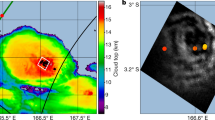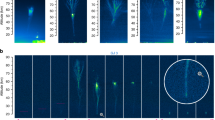Abstract
Thunderstorms occasionally produce upward discharges, called blue jets and gigantic jets, that propagate out of the storm top towards or up to the ionosphere1,2,3,4. Whereas the various types of intracloud and cloud-to-ground lightning are reasonably well understood, the cause and nature of upward discharges remains a mystery. Here, we present a combination of observational and modelling results that indicate two principal ways in which upward discharges can be produced. The modelling indicates that blue jets occur as a result of electrical breakdown between the upper storm charge and the screening charge attracted to the cloud top; they are predicted to occur 5–10 s or less after a cloud-to-ground or intracloud discharge produces a sudden charge imbalance in the storm. An observation is presented of an upward discharge that supports this basic mechanism. In contrast, we find that gigantic jets begin as a normal intracloud discharge between dominant mid-level charge and a screening-depleted upper-level charge, that continues to propagate out of the top of the storm. Observational support for this mechanism comes from similarity with ‘bolt-from-the-blue’ discharges5 and from data on the polarity of gigantic jets6. We conclude that upward discharges are analogous to cloud-to-ground lightning. Our explanation provides a unifying view of how lightning escapes from a thundercloud.
This is a preview of subscription content, access via your institution
Access options
Subscribe to this journal
Receive 12 print issues and online access
$259.00 per year
only $21.58 per issue
Buy this article
- Purchase on Springer Link
- Instant access to full article PDF
Prices may be subject to local taxes which are calculated during checkout




Similar content being viewed by others
References
Wescott, E. M., Sentman, D., Osborne, D., Hampton, D. & Heavner, M. Preliminary results from the Sprites94 aircraft campaign: 2. Blue jets. Geophys. Res. Lett. 22, 1209–1212 (1995).
Boeck, W. L. et al. Observations of lightning in the stratosphere. J. Geophys. Res. 100, 1465–1475 (1995).
Pasko, V. P., Stanley, M. A., Matthews, J. D., Inan, U. S. & Wood, T. G. Electrical discharge from a thundercloud top to the lower ionosphere. Nature 416, 152–154 (2002).
Su, H. T. et al. Gigantic jets between a thundercloud and the ionosphere. Nature 423, 974–976 (2003).
Rison, W., Thomas, R. J., Krehbiel, P. R., Hamlin, T. & Harlin, J. A GPS-based three-dimensional lightning mapping system: Initial observations in central New Mexico. Geophys. Res. Lett. 26, 3573–3576 (1999).
Mathews, J. D. et al. Electromagnetic signatures of the Puerto Rico blue jet and its parent thunderstorm. Eos Trans. AGU 83, F91 (2002); Fall Meet. Suppl., Abstract A62D-02.
Krehbiel, P. R. The Earth’s Electrical Environment 90–113 (Nat’l. Academy Press, Washington, 1986).
Williams, E. R. The tripolar structure of thunderstorms. J. Geophys. Res. 94, 13151–13167 (1989).
Kasemir, H. W. A contribution to the electrostatic theory of a lightning discharge. J. Geophys. Res. 65, 1873–1878 (1960).
Mazur, V. & Ruhnke, L. H. Common physical processes in natural and artificially triggered lightning. J. Geophys. Res. 94, 12913–12930 (1993).
Mazur, V. & Ruhnke, L. H. Model of electric charges in thunderstorms and associated lightning. J. Geophys. Res. 103, 23299–23308 (1998).
Coleman, L. M. et al. Effects of charge and electrostatic potential on lightning propagation. J. Geophys. Res. 108, 4298 (2003).
Raizer, Y. P., Milikh, G. M. & Shneider, M. N. On the mechanism of blue jet formation and propagation. Geophys. Res. Lett. 33, L23801 (2006).
Marshall, T. C. et al. Observed electric fields associated with lightning initiation. Geophys. Res. Lett. 32, L03813 (2005).
Wilson, C. T. R. Investigations on lightning discharges and on the electric field of thunderstorms. Phil. Trans. R. Soc. Lond. A 221, 73–115 (1921).
Wilson, C. T. R. A theory of thundercloud electricity. Proc. R. Soc. Lond. A 236, 297–317 (1956).
Riousset, J. A., Pasko, V. P., Krehbiel, P. R., Thomas, R. J. & Rison, W. Three-dimensional fractal modeling of intracloud lightning discharge in a New Mexico thunderstorm and comparison with lightning mapping observations. J. Geophys. Res. 112, D15203 (2007).
Lang, T. J. et al. The severe thunderstorm electrification and precipitation study. Bull. Am. Meteorol. Soc. 85, 1107–1125 (2004).
Rust, W. D. et al. Inverted-polarity electrical structures in thunderstorms in the Severe Thunderstorm Electrification and Precipitation Study (STEPS). Atmos. Res. 76, 247–271 (2005).
Behnke, S. A., Thomas, R. J., Krehbiel, P. R. & Rison, W. Initial leader velocities during intracloud lightning: Possible evidence for a runaway breakdown effect. J. Geophys. Res. 110, D10207 (2005).
Lyons, W. A. et al. Upward electrical discharges from thunderstorm tops. Bull. Am. Meteorol. Soc. 84, 445–454 (2003).
Pasko, V. P. & George, J. J. Three-dimensional modeling of blue jets and blue starters. J. Geophys. Res. 107, 1458 (2002).
Wescott, E. M., Stenbaek-Nielsen, H. C., Huet, P., Heavner, M. J. & Moudry, D. R. New evidence for the brightness and ionization of blue jets and blue starters. J. Geophys. Res. 106, 21549–21554 (2001).
Raizer, Y. P., Milikh, G. M. & Shneider, M. N. Leader–streamers nature of blue jets. J. Atmos. Sol. Terr. Phys. 69, 925–938 (2007).
Wescott, E. M., Sentman, D. D., Heavner, M. J., Hampton, D. L. & Vaughan, O. H. Jr. Blue jets: Their relationship to lightning and very large hailfall, and their physical mechanisms for their production. J. Atmos. Sol. Terr. Phys. 60, 713–724 (1998).
Petrov, N. I. & Petrova, G. N. Physical mechanisms for the development of lightning discharges between a thundercloud and the ionosphere. Tech. Phys. 44, 472–475 (1999).
Sukhorukov, A. I. & Stubbe, P. Problems of blue jet theories. J. Atmos. Sol. Terr. Phys. 23, 725–732 (1998).
Thomas, R. J. et al. Observations of VHF source powers radiated by lightning. Geophys. Res. Lett. 28, 143–146 (2001).
Williams, E. R. et al. Lightning flashes conducive to the production and escape of gamma radiation to space. J. Geophys. Res. 111, D16209 (2006).
Williams, E. R. Problems in lightning physics—the role of polarity asymmetry. Plasma Sources Sci. Technol. 15, S91–S108 (2006).
Acknowledgements
We thank E. R. Williams for comments on the paper and further references. T. Hamlin, J. Harlin, S. Kieft, W. Winn and S. Hunyady contributed to the operation and data processing of the Lightning Mapping Array at Langmuir Laboratory and during STEPS. The radar data of Fig. 2a were obtained by the National Center for Atmospheric Research S-Pol radar. The work was supported by the Physical and Dynamical Meteorology and Aeronomy Programs of the National Science Foundation.
Author information
Authors and Affiliations
Contributions
P.R.K. drafted the manuscript and developed the electrodynamic model. J.A.R. carried out the lightning simulations, prepared the figures and drafted the methods section. J.A.R. and V.P.P. developed the lightning simulation model. W.R., R.J.T. and P.R.K. developed the Lightning Mapping Array, conducted the field programs and carried out the data analyses for the study. M.A.S. carried out low-frequency measurements and analyses. H.E.E. obtained the photograph of Fig. 3b. All authors contributed to discussion of the results and preparation of the manuscript.
Corresponding authors
Supplementary information
Supplementary Information
Supplementary figures S1-S5 and table S1 (PDF 315 kb)
Rights and permissions
About this article
Cite this article
Krehbiel, P., Riousset, J., Pasko, V. et al. Upward electrical discharges from thunderstorms. Nature Geosci 1, 233–237 (2008). https://doi.org/10.1038/ngeo162
Received:
Accepted:
Published:
Issue Date:
DOI: https://doi.org/10.1038/ngeo162
This article is cited by
-
Evaluation of the performance of the World Wide Lightning Location Network (WWLLN) using the lightning detection network (LINET) as a truth
Bulletin of Atmospheric Science and Technology (2023)
-
Observation of the onset of a blue jet into the stratosphere
Nature (2021)
-
Optical emissions associated with narrow bipolar events from thunderstorm clouds penetrating into the stratosphere
Nature Communications (2021)
-
Progress in the Study of Transient Luminous and Atmospheric Events: A Review
Surveys in Geophysics (2020)
-
Climatology of Transient Luminous Events and Lightning Observed Above Europe and the Mediterranean Sea
Surveys in Geophysics (2020)



